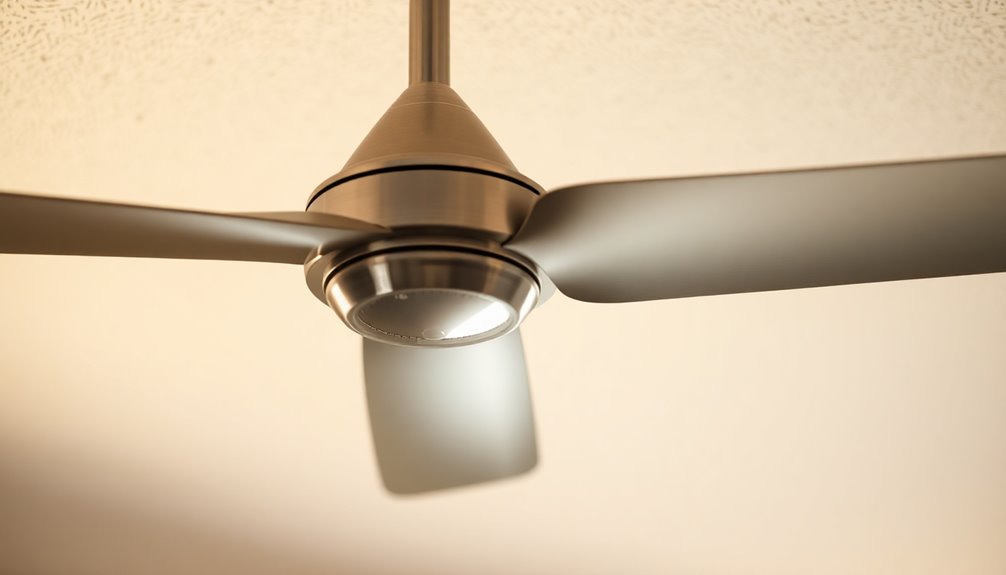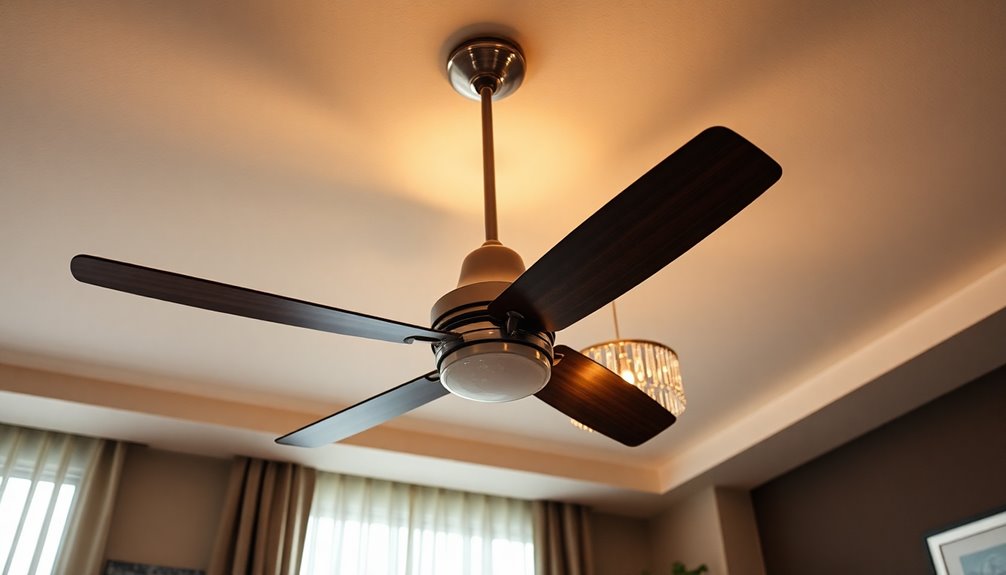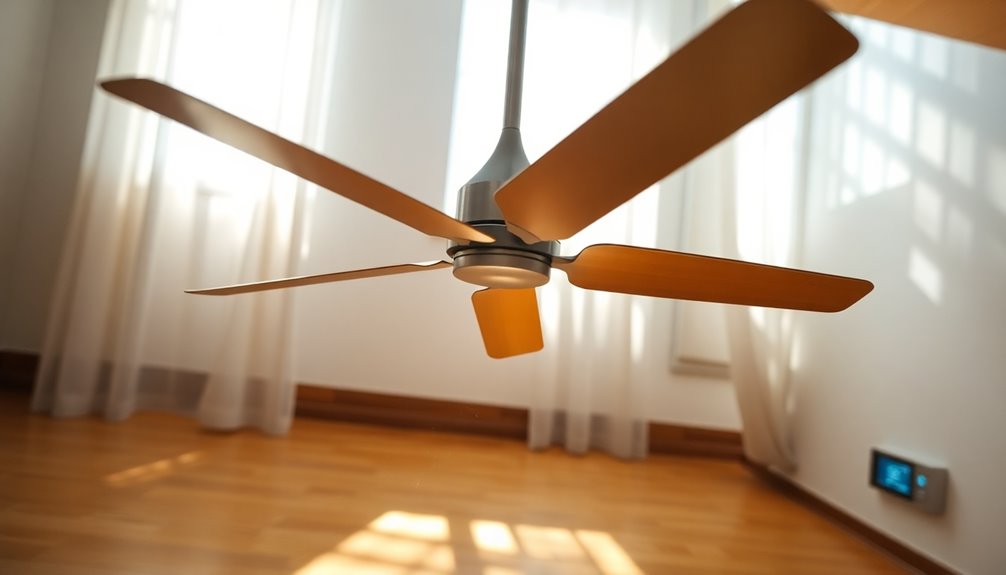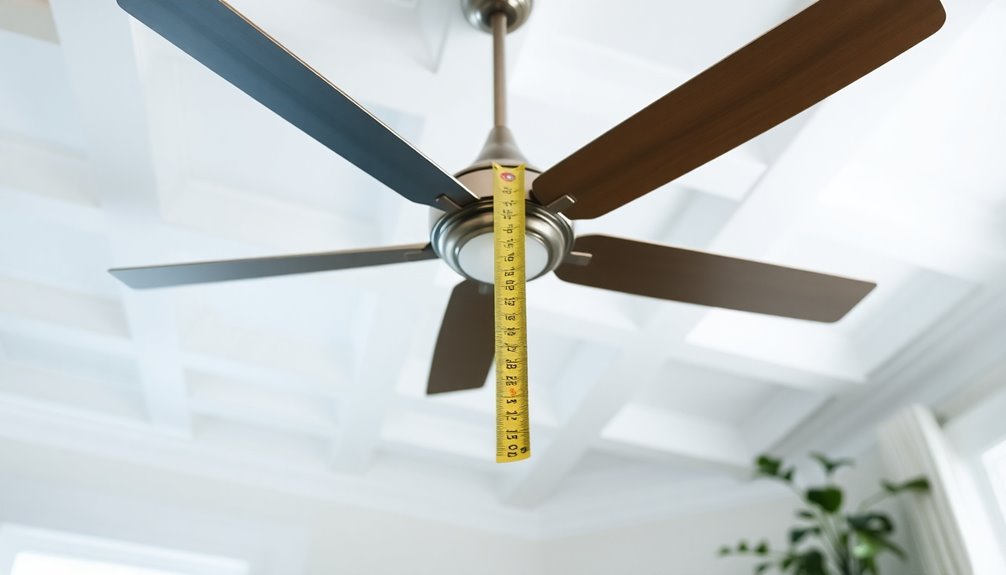Ceiling fans usually weigh between 10 to 50 pounds, depending on their design and size. Standard residential models typically range from 15 to 30 pounds. If you're looking at larger fans, they can weigh over 30 pounds, while industrial fans can go up to 400 pounds. The weight can be influenced by factors like the number of blades, motor size, and additional features such as lighting kits. It's essential to verify your ceiling can support the fan's weight, so you'll want to pay attention to mounting guidelines and safety regulations for a secure installation. You might discover more insights on this topic.
Key Takeaways
- Average residential ceiling fans weigh between 10 to 50 pounds, with standard models typically around 15 to 30 pounds.
- Heavier ceiling fans designed for larger spaces usually weigh between 25 to 30 pounds.
- Industrial ceiling fans can weigh significantly more, ranging from 100 to 400 pounds due to robust construction.
- Most ceiling fan junction boxes are rated to support 50 to 70 pounds, while heavy-duty boxes can support up to 200 pounds.
- Factors like the number of blades and motor size contribute to the overall weight of a ceiling fan.
Ceiling Fan Weight Overview

When it comes to ceiling fans, you'll find that their weight can vary considerably based on size and design. On average, residential ceiling fans weigh between 10 to 50 pounds, while larger industrial models can tip the scales at 100 to 400 pounds.
For standard ceiling fans, you can expect the weight to range from 15 to 30 pounds. The materials used in construction play a significant role in this variation.
If you're considering a heavier ceiling fan for a larger space, be aware that these models typically weigh between 25 to 30 pounds. This increased weight means you need to make sure your ceiling fan box is up to the task.
Most ceiling fan boxes are rated to support weights ranging from 50 to 70 pounds, but specialized boxes can handle up to 200 pounds.
Proper installation and support are vital when it comes to the weight of a ceiling fan. Exceeding the weight capacity of a ceiling fan box can lead to structural failures and safety hazards.
Factors Affecting Weight

Several key factors influence the weight of ceiling fans, so understanding these can help you choose the right model for your space. The average weight of standard residential ceiling fans typically ranges from 10 to 50 pounds, depending on the size and materials used. Heavier models, designed for larger areas or enhanced durability, can weigh 25 to 30 pounds or more.
Here's a quick overview of what affects ceiling fan weight:
| Factor | Description | Impact on Weight |
|---|---|---|
| Number of Blades | More blades add weight | Increases weight |
| Motor Size | Larger motors are heavier | Considerably increases weight |
| Additional Features | Integrated lighting kits add weight | Increases weight |
Additionally, ceiling fans intended for commercial or industrial use can weigh between 100 to 400 pounds due to their robust construction. The mounting method and ceiling box type also play vital roles in determining the weight rating and stability of your installation. Knowing these factors will help you select a ceiling fan that fits your needs and installation requirements.
Ceiling Fan Size and Weight

When you're choosing a ceiling fan, size and weight play an essential role in your decision.
Standard fans usually weigh between 15 to 18 pounds, but larger models can tip the scales at 25 to 30 pounds.
Keep in mind that heavier fans may require stronger mounting systems to guarantee everything stays secure.
Average Ceiling Fan Weight
In considering the average ceiling fan weight, you'll find it typically ranges from 10 to 50 pounds, influenced by size and materials.
Standard ceiling fans usually weigh around 15 to 18 pounds, making them manageable for most residential installations. If you're opting for a heavier model, expect it to weigh between 25 and 30 pounds.
For larger spaces, ceiling fans designed to hold the weight of more substantial blades and motors can weigh considerably more, often between 60 to 70 pounds. These fans are built to circulate air efficiently in expansive areas.
On the other hand, industrial or commercial ceiling fans can be a different ballgame, weighing between 100 to 400 pounds due to their robust construction meant for heavy-duty use.
When choosing a ceiling fan, keep in mind that the average ceiling fan weight is essential for installation.
It directly affects the kind of mounting hardware you'll need and the strength of the ceiling box. Always verify your ceiling can safely hold the weight of the fan you select to avoid any potential issues down the line.
Factors Affecting Weight
The weight of a ceiling fan is greatly influenced by its size and the materials used in its construction. When you're choosing a ceiling fan, consider these factors that impact its weight:
- Blade Span: Larger ceiling fans, especially those with blade spans of 60 to 70 inches, can weigh 30 pounds or more. Their bigger size often requires more robust components.
- Material Composition: The materials used in the fan's design play a significant role. Wooden blades tend to add more weight than plastic ones, affecting the overall ceiling fan weight.
- Design Complexity: Fans with advanced features, like integrated lighting or elaborate motor designs, generally weigh more. This added weight necessitates proper mounting solutions, as ceiling fan boxes are rated to support up to 70 pounds.
If you're considering a heavier ceiling fan for commercial or industrial use, keep in mind that these can weigh between 100 to 400 pounds.
Choosing the right ceiling fan that suits your space involves understanding how size and materials affect its weight.
Weight Limits for Installation

When installing a ceiling fan, it's essential to know the maximum weight capacity to guarantee safety.
You'll need to follow specific installation guidelines and use properly rated junction boxes, as non-rated ones can lead to serious issues.
Regularly checking your setup can help prevent accidents and keep everything secure.
Maximum Weight Capacity
Understanding the maximum weight capacity for ceiling fans is essential for a safe and effective installation. The weight capacity can greatly influence your choice of a ceiling fan, as exceeding this limit can lead to dangerous outcomes. Most residential ceiling fans typically weigh between 10 and 50 pounds, while heavy-duty fans can weigh much more.
Here are three critical points to reflect on regarding weight capacity:
- Standard Boxes: Most standard ceiling fan boxes support 50 to 70 pounds, while heavy-duty boxes can handle 150 to 200 pounds.
- Design and Mounting: The specific design and type of mounting can affect the weight capacity of your ceiling fan. Always check the manufacturer's specifications.
- Structural Support: The ceiling's structure, including joists, plays a crucial role in ensuring the fan's stability. According to the National Electrical Code (NEC), unlabeled electrical boxes must support at least 50 pounds. Additionally, choosing a ceiling fan with high airflow capacity can help ensure optimal performance while adhering to weight limits.
Installation Guidelines and Safety
Making certain a safe installation of your ceiling fan goes beyond just knowing its weight capacity; it also involves following specific guidelines to guarantee stability and safety.
First, make sure your ceiling box is rated to hold at least 50 pounds. Some specially designed boxes can support up to 70 pounds, so check the labels. If your junction box isn't labeled, it should still meet the minimum weight requirement according to the National Electrical Code (NEC) guidelines.
When installing, secure the electrical box to at least one ceiling joist using wood screws. Avoid using drywall screws, as they don't provide the necessary support for heavier fixtures. Properly attach the mounting brackets to make certain the fan is stable and prevent accidents.
Regularly inspect the junction box and its connections to make sure everything's secure. If you notice any signs of wear or instability, address them immediately.
Following these installation guidelines and being mindful of weight limits will help you enjoy your ceiling fan safely and effectively, without the worry of it falling.
Mounting Considerations

Proper mounting is vital for safely installing ceiling fans, especially given their weight and potential vibrations during operation. Standard residential ceiling fans weigh between 10 to 50 pounds, and heavier industrial fans can weigh considerably more.
To guarantee stability, you'll need to follow these mounting considerations:
- Use a fan-rated junction box: Make sure the junction box can support at least 50 pounds. This is essential for safety during fan operation.
- Securely attach to ceiling joists: Lightweight drywall won't hold the weight. Always fasten the junction box directly to the ceiling joists for maximum support.
- Consider mounting brackets: If you're installing a heavier fan, opt for reinforced or braced mounting boxes. These provide additional strength to handle the extra weight.
Regularly inspect your mounting setup to confirm it remains secure. Additionally, regular maintenance can prevent dangerous situations related to fan stability and performance.
Vibrations from the fan can affect stability over time, so it's wise to check your installation periodically. By following these mounting considerations, you can enjoy your ceiling fan safely and effectively, without worrying about potential issues down the line.
Safety Guidelines

After you've securely mounted your ceiling fan, it's important to follow specific safety guidelines to prevent accidents and guarantee smooth operation.
First, verify that your fan is supported by a fan-rated junction box, which can handle at least 50 pounds. This is essential for maintaining structural integrity and safety. If you're installing a heavier fan, opting for sturdy mounting brackets and securing them to ceiling joists or cross braces is necessary, especially since some fans can weigh up to 70 pounds.
Regular inspections of your installation are critical. Improper mounting can lead to severe accidents, with estimates of over 19,000 injuries annually due to falling ceiling fans.
Always adhere to the National Electrical Code (NEC) guidelines, which specify using a junction box labeled for fan support to confirm compliance with safety standards.
User Experiences

User experiences reveal a lot about the practical challenges of installing ceiling fans, especially heavier models. Many users have encountered difficulties when trying to mount fans that exceed 25 pounds, often leading to safety concerns.
Here are three key takeaways based on user feedback:
- Mounting Solutions: Heavier ceiling fans generally require stronger mounting brackets. Users found that standard junction boxes often lack the necessary weight capacity, leading to potential accidents.
- Installation Risks: Improper installation can result in dangerous situations, such as fans swinging or falling. Many users have shared stories of near misses, emphasizing the need for attention to detail during installation.
- Brand Preferences: Customers frequently express satisfaction with brands like Minka Aire and Haiku, which provide quiet operation and efficient airflow. These models typically weigh between 25 to 30 pounds, striking a balance between performance and manageable weight.
Maintenance and Care

Maintaining your ceiling fan is vital for guaranteeing its longevity and peak performance. Regular maintenance includes checking for loose screws and connections. This simple step helps guarantee safe operation and prevents potential accidents.
Dust buildup on fan blades can hinder efficiency and airflow, so make it a habit to clean them regularly. This not only boosts performance but also reduces energy consumption, helping you save on bills.
Periodically inspect the wiring for signs of wear or damage to prevent electrical hazards. If you notice any issues, address them immediately to keep your fan operating safely.
Properly balanced blades are essential; if your fan wobbles, adjusting or replacing them can prevent excess wear on the motor and extend its lifespan.
Lastly, don't forget about seasonal adjustments. Reversing blade direction for winter and summer settings optimizes comfort and energy efficiency throughout the year.
Frequently Asked Questions
What Is the Average Weight of a Ceiling Fan?
When you're considering a ceiling fan, it's important to know that the average weight typically falls between 10 to 50 pounds.
Standard models usually weigh around 15 to 18 pounds, while larger fans for spacious areas can weigh 25 to 30 pounds or more.
If you're looking at industrial fans, be prepared for weights ranging from 100 to 400 pounds.
Always check manufacturer specs to guarantee proper support and installation.
How Heavy Is a 52 Inch Ceiling Fan?
You might think the weight of a 52-inch ceiling fan isn't that important, but it really is!
Typically, these fans weigh between 15 to 20 pounds, with some heavier models reaching up to 30 pounds.
When you're selecting one, consider its weight for safety and verify your electrical box can support it.
This way, you'll enjoy a cool breeze without worrying about installation issues or potential hazards down the line.
Can You Install a Ceiling Fan on a Pancake Box?
You can't safely install a ceiling fan on a pancake box.
These boxes aren't designed to support the weight and motion of a fan, which could lead to potential hazards.
Instead, you should use a fan-rated junction box securely mounted to ceiling joists.
This guarantees your ceiling fan is stable and compliant with safety regulations.
Always check the manufacturer's guidelines and local codes for the right junction box for your installation.
What Is the Maximum Weight of a Ceiling Fan Box?
You might think a ceiling fan box could hold the weight of a small elephant, but the truth is a bit less dramatic.
The maximum weight a ceiling fan box can support typically ranges from 50 to 70 pounds, depending on its type.
Fan-rated junction boxes are built to handle at least 50 pounds, while specialized boxes can support even more.
Always check for the weight rating to guarantee safe installation.
Conclusion
In choosing a ceiling fan, remember that weight matters for installation, safety, and performance. Whether you seek style or function, knowing how much your fan weighs helps you make informed decisions. Embrace the balance of beauty and practicality, ensuring your space feels just right. When you prioritize safety and care, you create a home that's not only comfortable but also inviting. So, hang your fan with confidence, enjoy the breeze, and savor the comfort it brings.









